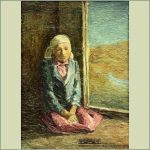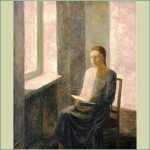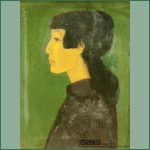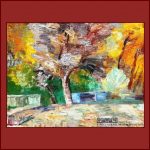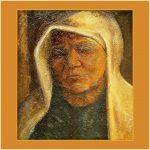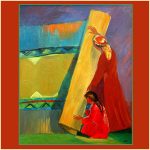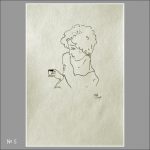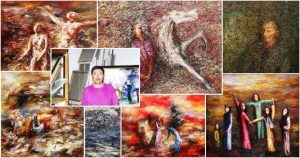 We continue to acquaint you with the works of artists of Kyrgyzstan from the collection of our national museum (GNMII) through the eyes of art critic GAMAL BOKONBAYEV. This is the first part of two dedicated to the work of Aitiev Satar.
We continue to acquaint you with the works of artists of Kyrgyzstan from the collection of our national museum (GNMII) through the eyes of art critic GAMAL BOKONBAYEV. This is the first part of two dedicated to the work of Aitiev Satar.
Satar Aitiev (1945) is a painter. Honored Artist of the Kyrgyz Republic. Born in the family of Gapar Aitiev, a famous artist, whose name is assigned to the state museum. Satar Aitiev received an excellent education as a film artist (VGIK – 1969). Works mainly in easel painting, in the genres of portrait, thematic composition, landscape, still life. He is also the author of a monumental work – the mosaic “Enlightenment” on the facade of the building of the Faculty of Chemistry of the Kyrgyz National University named after Jusup Balasagyn. Participant of the exhibitions since 1968.
 Apotheosis of war. Diptych. 94×108.5; 94х108.5, 1985, KNMII
Apotheosis of war. Diptych. 94×108.5; 94х108.5, 1985, KNMII
Art historian Olga Popova writes about this work as follows: “A new step in the development of his (Satar Aitiev’s) unique talent is the diptych “The Apotheosis of War”, written for the 40th anniversary of Victory in the Great Patriotic War. In this diptych, the artist was able, with great power of persuasion, to express the rejection of war through the theme of a woman…. If such paintings as “Song” are chamber in their sound, then the diptych “Apotheosis of War” sounds like a symphony of complex social content. Moreover, here the artist abandoned any narrative illustrativeness in solving the theme, resorting to the language of allegory, expressing an abstract concept with the help of a specific image. Nude female figures, painted with exceptional plastic power, are depicted in a kind of ritual frenzy, the nature of which is deciphered by the dynamics of the spatial environment created by the polyphony of color and texture whirlwind.
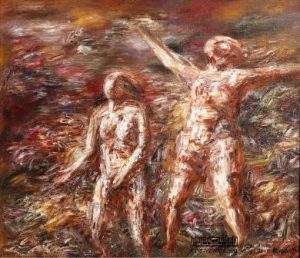 One part of the diptych depicts a lonely naked female figure, pressing her hands to her chest and lamenting. On the other side of the diptych are two women. One of them throws her hands up, calling to the sky, the other – with a gesture of impotence, lowers her hands to the ground. Prickly earth, hostile sky. Expression! Scream! Goddesses of motherhood scream in terror! Nakedness adds to the screams of primitive savagery… Maybe at one time, the picture looked like a challenge. A challenge to addiction, routine officialdom, window dressing of events and artistic order. Now we are used to such aesthetic protests. The theme is treated too cleverly, too abstractly! We got used to actions, performances, installations. In addition, the third world war seems already possible and not so terrible…. We have lost the gift of empathy! We are afraid of catharsis! We hesitate to cry. Artists have forgotten how to make concrete and talented, emotional use of live observations. Moreover, in art: the more specific, the more emotional, but this is the quintessence of realism! There is no realism, no specific history, and no specific person. There is no specific grief, horror, screaming, and painting has turned into a calculation … and has not become a philosophy.
One part of the diptych depicts a lonely naked female figure, pressing her hands to her chest and lamenting. On the other side of the diptych are two women. One of them throws her hands up, calling to the sky, the other – with a gesture of impotence, lowers her hands to the ground. Prickly earth, hostile sky. Expression! Scream! Goddesses of motherhood scream in terror! Nakedness adds to the screams of primitive savagery… Maybe at one time, the picture looked like a challenge. A challenge to addiction, routine officialdom, window dressing of events and artistic order. Now we are used to such aesthetic protests. The theme is treated too cleverly, too abstractly! We got used to actions, performances, installations. In addition, the third world war seems already possible and not so terrible…. We have lost the gift of empathy! We are afraid of catharsis! We hesitate to cry. Artists have forgotten how to make concrete and talented, emotional use of live observations. Moreover, in art: the more specific, the more emotional, but this is the quintessence of realism! There is no realism, no specific history, and no specific person. There is no specific grief, horror, screaming, and painting has turned into a calculation … and has not become a philosophy.
 Ak-Talaa bread. Oil on canvas, 71×90.7
Ak-Talaa bread. Oil on canvas, 71×90.7
Ak-Tala district is located in the Naryn region of the Kyrgyz Republic, includes river valleys and slopes of mountain ranges. Traditionally, Kyrgyz people cook bread in a tandoor oven. There are many variations; each region has its own traditions and recipes. The author saw that Ak-Tala bread is something special! The woman is holding a cake in her hands. The other one is busy preparing. Near the stove, tandoor, there is black smoke. The space is conditional; it can be a meadow, a hill, a yard. Largely, this is the feeling of the area. The artist sees it as red, yellow, black. Yellow is sunshine! Red spots – shadows from the clouds! Black and ocher – peasant labor! The air of the highlands, the heat from the tandoor, the smell of smoke!
What did the painter want to say with his work? For a modernist, this is a stupid question. The artist conveys his feelings and any verbal explanations are absolutely useless here. This is a painting, not a novel. The art critic Olga Popova writes the following about the author’s artistic method: “As a rule, the paintings of this artist are plotless; their pathos and figurative depth are achieved by the expressiveness of the form. You had better not say. One can only add – there is no mystery here, no strangeness, nothing… unusual. This is exactly the case when modernist abstraction turns … into a decorative panel. In addition, any stamped definitions that do not say anything can be applied to it: beautiful, original, talented, and so on! This is the quintessence of the era of developed socialism: the authorities do not mind, and the artist is satisfied. The main thing is that nothing happens, except for the unrest in the soul from meeting with the beautiful!
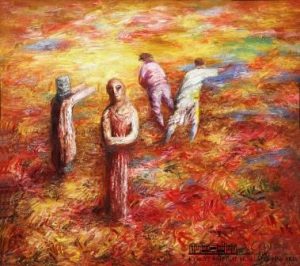 Reflection. Oil on canvas, 119.5×135, 1984
Reflection. Oil on canvas, 119.5×135, 1984
In the center of the composition, a woman stands to her full height and looks directly at the viewer. She folded her arms across her chest, questioning in her eyes. She is dressed in an antique tunic, with a scarf on her head. The center axis is shifted to the left. A little further on, an older woman, in a chapan* and elechek**, stands, stretching out her hands to the departing figures of young men. Is it about the destruction of the family? As in the brilliant story “Jamila”***! Only a few are caricatured. Is it about the destruction of traditions and unwillingness and children to live according to patriarchal patterns? Like in the brilliant film “Bakai’s Pasture”! However, the picturesque picture is not only about this – it is about the disunity of modern society in general! In addition, not about that either! It is about something more, elusive…. A woman in traditional dress asks plump urban half-baked boy. And the woman in the center is a universal symbol. This is a balance to which one must strive … however; it does not always work out…. On the eve of “perestroika”, the Republic found itself in a situation of uncertainty. I did not want to live as before, but I could not in a new way. In addition, when you plunge into the atmosphere of those years, you understand that this picture is an adequate reflection of that reality. Moreover, the situation of uncertainty continues to this day. For a long time the symbol of our Independence was a woman in antique clothes. Added the problem of labor migration. Now it is clear where the men are actually running…. Picturesque images created in the mid-80s of the last century are still relevant today. They are symbols that have found their form and have a life of their own. True, from frequent use, living symbols turn into caricature stamps.
* Chapan – traditional Kyrgyz outerwear
** elechek – traditional headdress of a married woman
*** “Jamila” – famous novel by Chyngyz Aitmatov
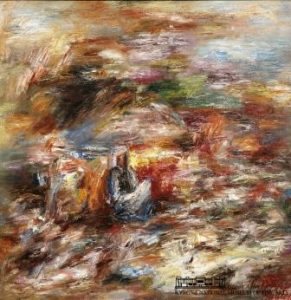 On jailoo*. Oil on canvas, 90×90, 1983, KNMI
On jailoo*. Oil on canvas, 90×90, 1983, KNMI
The canvas is square, the colors are colorful, the forms are abstract, the painting is impasto, and the seated woman stands out. It does not matter what she thinks. Everything was mixed up in a heap: dry grass, the edge of the yurt, a felt, a piece of blue sky, a dark cloud and slanting rain. Does it look like jailoo? … New forms are needed for new works. The author tries to change the style, but the experiment failed, and the new forms do not say anything. Not acquired, not rethought, not overwhelmed and not found. Yes! The artist is free in his work! However, freedom has a downside. Boundless freedom leads to frustration and to a sense of the meaninglessness of life, which fills everything and nothing else matters. There is no context, no idea, no meaning – there are only enchanting, infinitely beautiful, exquisitely colorful spots of a magnificent carpet pattern. The picture has a specific name, but it is unlikely that it is about life in jailoo. Moreover, it does not seem that the painting reflected the conditions in which it was created… But we must to admit: sometimes it seems that something … elusive is guessed in these abstract abstractions! About time, about myself, about life in jailoo.
* jailoo – summer pasture
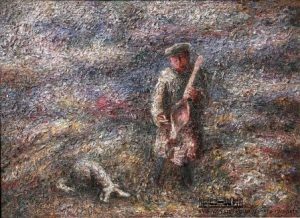 Song. Oil on canvas, 67×90, 1982
Song. Oil on canvas, 67×90, 1982
In a conditional space, an elderly man in a cap and raincoat is standing and playing the kyyak. Nearby lies a dog, a taigan with long ears. The man is one-legged, with a prosthesis, probably a disabled veteran of the Great Patriotic War. Guard, huntsman, lineman? The name sets you in an epic mood, something historical or heroic! This is a character in the brilliant stories of Chyngyz Aitmatov! Plays a song about universal loneliness! In 1980, the novel “Stormy Station” (And the Day Lasts Longer than a Century) was published. He immediately became incredibly popular and, of course, attracted the attention of artists. The heroes of Chyngyz Aitmatov have always attracted illustrators with their ambiguity. However, the character of this picture is not like anyone else. Kyyak, taigan, prosthesis make it original. The artist created a generalized image. He has his own recognizable handwriting, primitive drawing, and prickly texture. Nevertheless, here we see an illustration. We see the characters of the classics of national literature everywhere! We see it that way! In addition, we deny originality to the original picture! This case shows how much influence Chyngyz Aitmatov had on our visual culture. The modernist tried to overcome this dependence and failed. This case suggests that the case is not in the form. It is a matter of a little. A little bit acceptable and this is already an illustration of the Great work of the Great writer. Typical illustration – no more. This is the most unoriginal, not easel, work of a rather original artist.
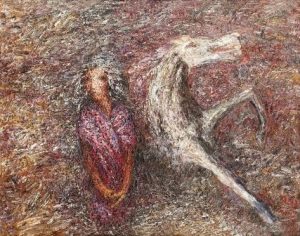 Memory. Oil on canvas, 71×90, 1982
Memory. Oil on canvas, 71×90, 1982
A girl is squatting; a white horse is beating her hoof next to her. It seemed to have arisen from underground; the lower part is not visible. Most likely, this is a figment of the imagination of a lonely city girl. She is a dark-skinned girl in a summer lilac wrap dress. Without a scarf. She has a trendy hairstyle bleached with hydrogen peroxide… or an artist’s palette? She looks into the distance, into the vast depths of her subconscious. This picture is a mystery and one can only make assumptions. Judging by the name, is this the memory of distant ancestors? It does not look like… About eternal archetypes? About the primal instinct of a foal, hidden behind the conventions of civilization? Memory remembers a lot … Stagnation turned into senile insanity. However, it was impossible to talk about it directly, and it was not necessary. In the paradigm of modernism: a painting is always an unsolved riddle. In the works of the main representatives of the Kyrgyz pictorial modernism – Satar Aitiev, Aman Asrankulov, Jambul Jumabaev – there is always the inexpressible. In the USSR, they are hostages of something that is barely visible in the pictures. Just a hint. In an unusual texture, in dissonant combinations, in strange characters. These pictures will cause indignation of some, and “others” will understand from what source this sweet poison of decadence pours.
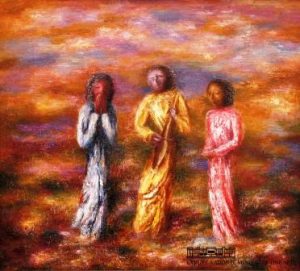 Trio. Youth of Kyrgyzstan. 1983. Canvas, oil, 90×100
Trio. Youth of Kyrgyzstan. 1983. Canvas, oil, 90×100
This is a continuation of the topic. In addition, the theme is like an obsession. The picture is connected with the events of the past era, but in a somewhat strange way … Back in 1984, the country was going to celebrate the 60th anniversary of Soviet Kyrgyzstan, the Communist Party and … the Komsomol of Kyrgyzstan! (The year 1924 was “appointed” as the year of the beginning of the process of formation of the Republic and all its power structures). Large-scale festivities, speeches, toasts … exhibitions were supposed to show the achievements of the national economy and, of course, about the young. Artists had to present something new, software! Something fervent, Komsomol! Tired of the old-fashioned way. Recall that the “Portrait of a Contemporary” appeared on the 50th anniversary of Soviet Kyrgyzstan, the Communist Party and the Komsomol. In addition, a decade later – this work…. Trio on the hill. One girl plays the temir komuz, the other plays the kyyak, but the third one… It seems that she is holding a folk percussion-noise instrument, wooden cups or cymbals in her hands. Karsyldak? This is a question…. According to the plot, everything seems to be correct; the style is monumental-decorative, national in form. Girls do not forget traditions and glorify modern life. However, the image itself! It is strange! Aesthetically fashionable blurry patterns, abstract concert costumes. Invented: earth, sky, clouds. Free improvisation, pasty technique, fine-grained texture and primitive drawing. Why is there primitivism here? Gives movement? Adds authenticity? Demonstratively primitive. With a challenge! “Yes, we are Scythians! Yes, we are Asians…” There was no scandal. If he was, then he was quickly hushed up, patriarchal good breeding was shown. The talented art historian Olga Popova cleverly wrote about the artist’s right to have “his own formalistic conception.” The audience decided: “The artist should be pitied; he sees it that way, poor thing.” However, the desire for a scandal from the major artist involuntarily told about something more – modern youth is primitive!
 Song (Youth of Kyrgyzstan). Oil on canvas, 89.8×100.2, 1981
Song (Youth of Kyrgyzstan). Oil on canvas, 89.8×100.2, 1981
The well-known art historian Olga Popova writes about this work as follows: “The artist … simplified the image of a person to a schematic volumetrically interpreted sign, a kind of puppet with a ghostly life that flows in a closed space-time according to its own microcosmic laws. The outwardly static works of S. Aitiev have the quality of internal movement, the passion of vague dreams, expressed, however, by a clearly formulated pictorial system. Girls in a ghostly microcosm, in a field or on a hill, on brown earth. Cloudy sunset sky above. It looks like they are playing airplanes, and how they make memorized figures at the parade. The colors of the dresses are yellow, blue, and green, red. Are these symbols? Maybe they are waiting for someone in the evening? Moreover, they give conventional signs from the mountain, fanned by “the passion of vague dreams” … Grotesqueness, theatricality – this is the assessment given by many Soviet art historians to the experiments of Soviet artists during the years of stagnation. Wretched and sympathetic characters appear in art: the hillbilly Vasily Shukshin, city freaks from Victoria Tokareva, the comedies of Eldar Ryazanov, Georgy Daneliya, and so on … But in this case, sympathy does not arise. There is wretchedness, but there is no sympathy! Monstrous dolls. This is already an open mockery of the patterns of social realism, as in social art, but deeper. The official conceptualism of Soviet Kyrgyzstan! Too bad the name was not picked up in time. It could be called “frightening socialist realism.” The tension in the faces and figures, as in the brilliant canvases of Semyon Afanasyevich Chuikov about the Uprising of 1916! … Is this the youth of Kyrgyzstan? Therefore, this phenomenon remained unexplored and not understood.
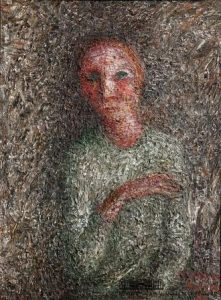 Motive. Oil on canvas, 40×60.9. 1978
Motive. Oil on canvas, 40×60.9. 1978
Before us is a half-length portrait of an unknown person in a pale green T-shirt. Thin and frail, and the little hand hung limply without strength. Pink complexion, rather sickly; alert green eyes, like an alien; it is not clear what is on the head: a hairstyle or a scarf? The author called the work “motive”. This is done when there is a feeling, but there are no specific words. Is this a teenager? Maybe a portrait of a citizen? Asphalt Kirghiz. Strange creature. No gender, no nationality. A descendant of brutal nomads, whom the city turned into a sissy and squishy. Moreover, even on the “Scream *” no strength. Coarse-grained texture, shavings and sawdust mixed in cement. The character appears after repair from sterile cleanliness. The artist saw the type, was surprised and depicted. He interpreted in accordance with the ideas of his time. Now there are many! Moreover, they look different … a little more attractive…. Accustomed to take up less space, not to stand out, to yield. Yet it is not sympathetic. In addition, eccentric townspeople must be loved. “It was they who erected multi-storey buildings, laid sewerage and water pipes, paved the streets and lit them with electric lamps. In addition, when everything was ready, “when the city took on a relatively comfortable look” … visitors appeared. Moreover, they decided that the townspeople – this is not it. Not the ones you can count on. Wrong! It is necessary to fall in love with meek and clever townspeople. In addition, the picture is not about the primitive features of modern life – about the high spirituality of those carried away by Dostoevsky. These are urban in the second generation and their beauty is completely different.
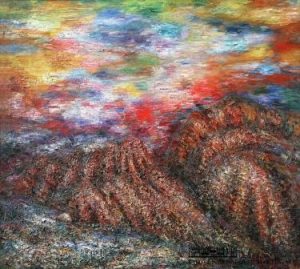 Evening. 90х100, 1979
Evening. 90х100, 1979
In the late 70s, bright shades appeared in the author’s palette: red, yellow, blue, green. What is it? Psychologically, this is understandable: the gloomy palette of decadence begins to bother, the monochromatic noir tires…. In the famous landscapes of Gapar Aitiev, the father of Satar Aitiev, abstract top and real bottom are harmoniously combined. This contrast becomes a feature of the Kyrgyz landscape. In the works of his son, this fruitful line continues, but in a different way. Above is a variegated-colorful pattern, vaguely reminiscent of the real sky. The mountains and the earth from below are also depicted conditionally. It can be anything. This is a brutal texture, consisting of stones and grains of sand. These are clay, leather, and thick-wadded robes. A monster with a hump, whose head is hidden in the fog. Grotesque and theatricality…. White light recedes, consisting of all the colors of the rainbow. However, this aniline “traffic light” is not at all like the reflections of the setting sun. That does not happen. Most likely, these are the rainbow lights of the night city. They step on nature, on the mountains. In addition, modern ala kiyiz is a motley tinsel of neon signs. Nobody has done that yet! No one compared the ancient ornament and the light pattern of the night city. A lone boulder stands out on the left, according to compositional laws, it becomes the main one. He is very small and lonely, hid or got lost, leaned against the slope and silently cries….
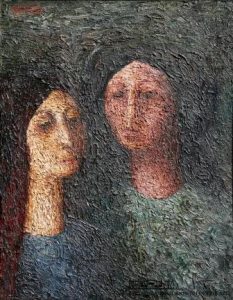 Portrait. Oil on canvas, 60×47, 1978
Portrait. Oil on canvas, 60×47, 1978
Two girls, friends, sisters, mysteriously appear from the darkness. Black shocks of hair, like, barely distinguishable, voluminous masses. Identical dresses – emerald green and azure blue. One is pale, the other is swarthy, both are equally dreamy, equally peer into the vast world. It is reflected in their frightened eyes with blackness…. Barely perceptible movement to the left. The one on the left leaned forward, holding on, and the one on the right moved forward, taking over the entire space. The girls seem to be dancing and hoping for attention. Touching and defenseless. In addition, the main axis of work is this unstable diagonal between them. Why? In addition, why is the work called a portrait? Double portrait? Or are they two aspects of one? Theatrical masks? There is no tragedy, no comedy. This is the same! … Olga Popova rightly points out: “This world is close to the world of music boxes and nutcrackers”. This is a toy, fictional world, no tragedy, no comedy. Without strong feelings, without sweet inspirations. Time for half hints. A stagnant era of taken away reality. Something was indicated – romantic, beautiful, and original. However, the unstable must become unreal, indistinguishable; dissolve in the vast, alien, incomprehensible world of collective action.
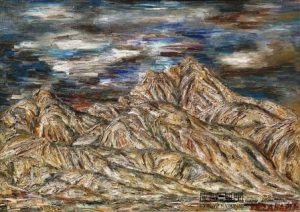 Portrait. Oil on canvas, 60×47, 1978
Portrait. Oil on canvas, 60×47, 1978
Two girls, friends, sisters, mysteriously appear from the darkness. Black shocks of hair, like, barely distinguishable, voluminous masses. Identical dresses – emerald green and azure blue. One is pale, the other is swarthy, both are equally dreamy, equally peer into the vast world. It is reflected in their frightened eyes with blackness…. Barely perceptible movement to the left. The one on the left leaned forward, holding on, and the one on the right moved forward, taking over the entire space. The girls seem to be dancing and hoping for attention. Touching and defenseless. In addition, the main axis of work is this unstable diagonal between them. Why? In addition, why is the work called a portrait? Double portrait? Or are they two aspects of one? Theatrical masks? There is no tragedy, no comedy. This is the same! … Olga Popova rightly points out: “This world is close to the world of music boxes and nutcrackers”. This is a toy, fictional world, no tragedy, no comedy. Without strong feelings, without sweet inspirations. Time for half hints. A stagnant era of taken away reality. Something was indicated – romantic, beautiful, and original. However, the unstable must become unreal, indistinguishable; dissolve in the vast, alien, incomprehensible world of collective action.
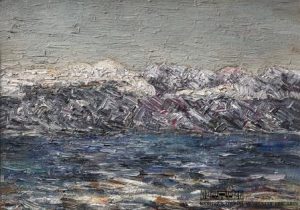 Silvery Issyk-Kul sparkles. Oil on canvas, 66×44.5, 1972
Silvery Issyk-Kul sparkles. Oil on canvas, 66×44.5, 1972
The young artist wants to expose the metaphysics of national nature and consistently removes everything superfluous, transient – leaving only the lake, mountains, sky. He refuses all the banal tricks of traditional painting and descends to the level of texture, which always a perfect abstraction. Away with the artful imitation of life! Long live sacred primitive and talking coloring. The modernist wants to prove that oil paint with its silvery texture and sparkling matter can make an exciting impression. Exciting metaphysics! And he succeeds! It is possible to show other waves, other slopes, and  another depth. The young artist finds his creative method. Instead of plot realism – abstractionism. Instead of details – a microcosm of brutalism. Instead of stencil patterns – national in a ragged rhythm, in the absence of geometry, in the wild element of felt, without established shores…. Visual Revolution! Urban intellectuals perceived such painting as their own, “other”, not official, not socialist realist lie and not a harsh whim. As an authentic element of real life, miserable today and promising tomorrow. The Age of Miracles continues in Soviet Kyrgyzstan in the 70s!
another depth. The young artist finds his creative method. Instead of plot realism – abstractionism. Instead of details – a microcosm of brutalism. Instead of stencil patterns – national in a ragged rhythm, in the absence of geometry, in the wild element of felt, without established shores…. Visual Revolution! Urban intellectuals perceived such painting as their own, “other”, not official, not socialist realist lie and not a harsh whim. As an authentic element of real life, miserable today and promising tomorrow. The Age of Miracles continues in Soviet Kyrgyzstan in the 70s!
Gapar Aitiev. Sparkling lake. 1960
 Portrait of academician Adyshev M.P. Oil on canvas, 94.5×75, 1975-1976
Portrait of academician Adyshev M.P. Oil on canvas, 94.5×75, 1975-1976
Musa Mirzapayazovich Adyshev (1915-1979) – Doctor of Geological and Mineralogical Sciences (1969), Professor (1971), Director of the Institute of Geology of the Academy of Sciences of the Kirghiz SSR (1953-1975). Member of the Presidium (1957-1979), and then President of the Academy of Sciences (1978). Member of the Supreme Council of the Kirghiz SSR (1975-1979) … From the mid-1950s, the formation of a new intelligentsia of Soviet Kyrgyzstan began. In the 1960s and 1970s, Kyrgyz artists created a large-scale cycle of pictorial and sculptural portraits. Thanks to this, in the fine arts of Soviet Kyrgyzstan there is a wonderful world inhabited by outstanding personalities, strong and talented. In 1975, T. Sadykov creates a wonderful sculpture “Academician Musa Adyshev”. In addition, in 1979, a very peculiar portrait of the academician was painted by Satar Aitiev’s father, Gapar Aitiev…. Works made by Kyrgyz modernists enrich the cycle of socialist realist portraits, bring diversity and depth. Ambiguities and paradoxes! This picture is not about how scientists, devoted to the Party and the people, are valued in our country, how they are showered with awards and positions. Not about complacency, and not even about ascetic workers. This is a representation of the science of the modernist artist. There is nothing, the light only catches the face and hands. Dark suit, shirt, tie. Shimmering geological formation of oil paints. Portrait resemblance in the eyes cut with a palette knife. The fingers are folded into a mysterious formula that no one can figure out. It seems that the line of the table is indicated. Or does it seem? If you gaze long into the luminous substance to the left of the figure, you begin to embrace the chaos of eternal matter and the will of the world spirit, and familiar faces appear in the darkness…
<= ISSUE 8 TO BE CONTINUED
Telegram-channel in Kyrgyz & Russian:
Санжарбек Данияровдун коомдук фонду
Фонд Санжарбека Даниярова
Subscribe if interested





